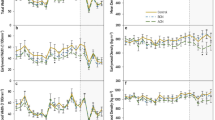Abstract
We examined 4-year growth of 15-year-old damaged and undamaged Douglas fir (Pseudotsuga menzesii) after integrating temporary population reductions of mountain beaver (Aplodontia rufa) with thinning in a pre-commercial hand-planted plantation in western Washington. Five treatment combinations were considered: (1) trapping mountain beavers in an unthinned area, (2) trapping before thinning to 65 trees/ha (160 trees/ac), (3) no trapping and thinning to 65 trees/ha, (4) no trapping and thinning to 146 trees/ha (360 trees/ac), and (5) no trapping and no thinning. Removal of ≥90 % of mountain beavers temporarily reduced mountain beaver activity whether the stand was unthinned or thinned. Diameter growth at breast height (dbh) was greater for undamaged trees than for damaged trees in thinned areas. Tree height growth was greatest in trapped areas whether thinned or not. No differences were detected in 4-year survival between trees damaged aboveground and those without aboveground damage, which may be related to undetected root damage to trees without aboveground damage. Basal diameter growth and dbh growth were greatest for areas thinned to 65 trees/ha. Seventy-eight percent of stomachs from mountain beaver trapped in winter contained Douglas fir root or stem materials. Overall, short-term removal of mountain beavers integrated with pre-commercial thinning promoted growth of crop trees.
Similar content being viewed by others
References
Arjo WM, Nolte DL (2006) Boomer or bust: managing a Pacific Northwest pest species. In: Timm RM, O’Brien JM (eds) Proc. 22nd Vertebr. Pest Conf., Univ. of Calif.-Davis, Davis, CA, p 181–186
Arjo WM, Huenefeld RE, Nolte DL (2007) Mountain beaver home ranges, habitat use, and population dynamics in Washington. Can J Zool 85:328–337
Black HC, Lawrence WH (1992) Animal damage management in Pacific Northwest forests: 1901-1990. In: Black HC (ed) Silvicultural approaches to animal damage management in pacific northwest forests. USDA, Forest Service, Pacific Northwest Research Station. Tech. Rep. PNW-GTR-287. Portland, OR, p 23–55
Borrecco JE, Anderson RJ (1980) Mountain beaver problems in the forests of California, Oregon, and Washington. In: Clark J, Marsh RE (eds) Proc 9th Vertebr. Pest Conf.Univ. of Calif.-Davis, Davis, CA, p 135–142
Borrecco JE, Anderson RJ, Black HC, Evans J, Guenther KS, Lindsey GD, Mathews RP, Moore TK (1979) Survey of mountain beaver damage to forests in the Pacific Northwest, 1977. State of Washington, Dept. of Natural Resources, DNR Note #26, Olympia, WA
Cafferata S (1992) Silvicultural methods in relation to selected wildlife species-mountain beaver. In: Black HC (ed) Silvicultural approaches to animal damage management in Pacific Northwest forests. USDA, Forest Service, Pacific Northwest Research Station, Technical Report PNW-GTR-287, Portland, p 231–251
Campbell DL (1993) Nest removal reduces reinvasion by mountain beaver (Aplodontia rufa). Northwest Sci 67:126
Campbell DL (1994) Mountain beavers. In: Hygnstrom S, Timm R, Larson G (eds) Prevention and control of wildlife damage, great plains animal damage. University of Nebraska, Lincoln, pp B-53–B-60
Campbell DL, Evans J (1975) “Vexar” seedling protectors to reduce wildlife damage to Douglas-fir. Leaflet No. 508., USDI Fish Wild. Serv., Washington, DC
Campbell DL, Evans J (1978) Establishing native forbs to reduce black-tailed deer damage to Douglas-fir. Proc. 8th Vertebr. Pest. Conf. Univ. Cal. Davis, p 145–151
Campbell DL, Evans J (1988) Recent approaches to controlling mountain beavers (Aplodontiarufa) in Pacific Northwest forests. In: Crabb AC, Marsh RE (eds) Proc. 13th Vertebr. Pest Conf. Univ. of Calif.-Davis, Davis, CA, p 183–187
Campbell DL, Evans J (1989) Aversive conditioning with thiram to reduce mountain beaver damage to Douglas fir seedlings. Northwest Sci 63:70
Campbell DL, Evans J, Engeman RM (1987) Deer repelled from Douglas-fir new growth using BGR-P and aversive conditioning. Washington State Department of Natural Resources Technical Publication, No. 46, Olympia, WA
Campbell DL, Farley JP, Engeman RM (1992) Field efficacy of pelleted strychnine baits for control of mountain beavers (Aplodontiarufa). In: Borrecco JE, Marsh RE (eds) Proc. 15th Vertebrate Pest Conf., p 335–339
Carey MC, Campbell DL, Campbell CL (1989) Physical structure, flora, and fauna of mountain beaver nests. Northwest Sci 63:70
Engeman RM, Campbell DL, Evans J (1991) An evaluation of 2 activity indicators for use in mountain beaver burrow systems. Wildl Soc Bull 19:413–416
Evans J (1984) Mountain beaver. The encyclopedia of mammals. In: MacDonald P (ed) Facts on file. Facts on File Publ, New York, p 610–611
Farley JP, Campbell DL (1992) Winter food caching by mountain beavers (Aplodontiarufa) in a girdled Douglas fir stand. Northwest Sci 66:120
Hooven EF (1977) The mountain beaver in Oregon: its life history and control. Res. Paper 30. Oregon State Univ. Forest Res. Lab, Corvallis OR
Hoyer GE, Anderson N, Riley R (1979) A case study of six years of mountain beaver damage on the Clallam Bay western hemlock plots. Wash. Dept. Nat. Res., DNR Note No. 28, Olympia, WA
King JE (1958) Development of a stand of coniferous reproduction and interplanted Douglas-fir. Northwest Sci 32:1–8
Martin P (1971) Movements and activities of the mountain beaver (Aplodontiarufa). J Mammal 51:717–723
Poelker RJ, Hartwell HD (1973) Black bear of Washington. Biol. Wash. State Game Dept. Bull. No. 14
Radwan MA, Campbell DL (1967) Snowshoe hare preferences for spotted catsear flowers in western Washington. J Wildl Manag 32:104–108
Author information
Authors and Affiliations
Corresponding author
Additional information
Responsible editor: Philippe Garrigues
Rights and permissions
About this article
Cite this article
Campbell, D.L., Engeman, R.M. & Farley, J.P. Effects of mountain beaver management and thinning on 15-year-old Douglas fir growth and survival. Environ Sci Pollut Res 22, 10824–10829 (2015). https://doi.org/10.1007/s11356-015-4297-x
Received:
Accepted:
Published:
Issue Date:
DOI: https://doi.org/10.1007/s11356-015-4297-x




